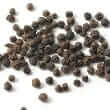Background
- Black pepper (Piper nigrum) is native to India and other southeastern Asian countries. Black pepper, white pepper, green pepper, pink pepper, and red pepper are all differently preserved berries or seeds of the Piper nigrum plant. Although black pepper has been used as a spice for millennia, it has also traditionally been used in India to treat diarrhea. In the Ayurvedic tradition, a preparation called Trikatu (black pepper, long pepper, and ginger) is prescribed routinely for a variety of diseases.
- Recent laboratory studies indicate that black pepper may also be beneficial in pain and Alzheimer's disease. In clinical trials, inhalation of black pepper oil improved withdrawal symptoms of cigarette smoking and the ability to swallow in post-stroke patients and in children with neurologic disorders.
- Ingestion of black pepper may cause dyspepsia (upset stomach) and other gastrointestinal adverse effects. Inhalation of black pepper has caused respiratory irritation, edema, and even respiratory arrest, severe anoxia, and death. There may also be a link between ingestion of black pepper and nasopharyngeal or esophageal cancer.
- The U.S. Food and Drug Administration (FDA) has approved black pepper, black pepper oil, black pepper oleoresin, piperidine, and piperine as Generally Recognized as Safe (GRAS) for use in foods in the United States.
References
Natural Standard developed the above evidence-based information based on a thorough systematic review of the available scientific articles. For comprehensive information about alternative and complementary therapies on the professional level, go to . Selected references are listed below.
- Arias Irigoyen J, Talavera Fabuel A, Maranon Lizana F. Occupational rhinoconjunctivitis from white pepper. J Investig Allergol Clin Immunol 2003;13(3):213-215.
View Abstract - Chaudhry NM, Tariq P. Bactericidal activity of black pepper, bay leaf, aniseed and coriander against oral isolates. Pak J Pharm Sci 2006;19(3):214-218.
View Abstract - D'Souza P, Amit A, Saxena VS, et al. Antioxidant properties of Aller-7, a novel polyherbal formulation for allergic rhinitis. Drugs Exp Clin Res 2004;30(3):99-109.
View Abstract - Ebihara T, Ebihara S, Maruyama M, et al. A randomized trial of olfactory stimulation using black pepper oil in older people with swallowing dysfunction. J Am Geriatr Soc 2006;54(9):1401-1406.
View Abstract - Fazekas B, Tar A, Kovacs M. Aflatoxin and ochratoxin A content of spices in Hungary. Food Addit Contam 2005;22(9):856-863.
View Abstract - Freeman, S., Ebihara, S., Ebihara, T., Niu, K., Kohzuki, M., Arai, H., and Butler, J. P. Olfactory stimuli and enhanced postural stability in older adults. Gait.Posture. 2009;29(4):658-660.
View Abstract - Ingkaninan K, Temkitthawon P, Chuenchom K, et al. Screening for acetylcholinesterase inhibitory activity in plants used in Thai traditional rejuvenating and neurotonic remedies. J Ethnopharmacol 2003;89(2-3):261-264.
View Abstract - Lambert JD, Hong J, Kim DH, et al. Piperine enhances the bioavailability of the tea polyphenol (-)-epigallocatechin-3-gallate in mice. J Nutr 2004;134(8):1948-1952.
View Abstract - McNamara FN, Randall A, Gunthorpe MJ. Effects of piperine, the pungent component of black pepper, at the human vanilloid receptor (TRPV1). Br J Pharmacol 2005;144(6):781-790.
View Abstract - Munakata, M., Kobayashi, K., Niisato-Nezu, J., Tanaka, S., Kakisaka, Y., Ebihara, T., Ebihara, S., Haginoya, K., Tsuchiya, S., and Onuma, A. Olfactory stimulation using black pepper oil facilitates oral feeding in pediatric patients receiving long-term enteral nutrition. Tohoku J Exp.Med 2008;214(4):327-332.
View Abstract - Pattanaik S, Hota D, Prabhakar S, et al. Effect of piperine on the steady-state pharmacokinetics of phenytoin in patients with epilepsy. Phytother Res 2006;20(8):683-686.
View Abstract - Pratibha N, Saxena VS, Amit A, et al. Anti-inflammatory activities of Aller-7, a novel polyherbal formulation for allergic rhinitis. Int J Tissue React 2004;26(1-2):43-51.
View Abstract - Siddiqui BS, Gulzar T, Begum S, et al. Piptigrine, a new insecticidal amide from Piper nigrum Linn. Nat Prod Res 2004;18(5):473-477.
View Abstract - Subehan Usia T, Kadota S, Tezuka Y. Mechanism-based inhibition of human liver microsomal cytochrome P450 2D6 (CYP2D6) by alkamides of Piper nigrum. Planta Med 2006;72(6):527-532.
View Abstract - Westerterp-Plantenga M, Diepvens K, Joosen AM, et al. Metabolic effects of spices, teas, and caffeine. Physiol Behav 8-30-2006;89(1):85-91.
View Abstract







